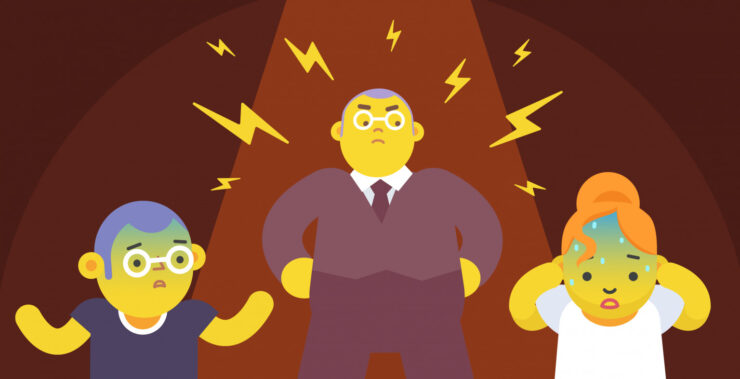We’ve all had dreadful mornings, difficult weekdays, and even frustrating months. You can usually get through a horrible morning, or a difficult week, and acquire vital insights from a poor quarter but it’s not easy to get through a toxic work environment.
It’s even difficult to accept that you may work in a toxic environment, and possibly even more difficult to perceive it.
However, the indications are relatively common. They are, unfortunately, more common than you might assume.
What is a toxic work environment?
A toxic work environment is one in which employees struggle to perform or move up the career ladder as a result of the unpleasant environment and frequent breakdowns fostered by toxic coworkers, toxic employees, toxic bosses, or the company culture.
A toxic work environment is more of a feeling than a criterion. Employees can tell if they’re working in a toxic workplace because of their gut feeling or perhaps any physical reactions they experience. This feeling can be compounded by chronic stress and anxiety, and even physical ailments such as headaches or digestive problems, which are common signs of prolonged exposure to a toxic work environment.
To figure out if you’re working in a toxic work environment, ask yourself if your workplace corresponds with your value system.
Your value system consists of your principles, which are fundamental to who you are as an individual. It’s what you base your identity, actions, and opinions on. Core beliefs are strong principles that you may not compromise on, as a person. It is a good indicator that something is wrong if the workplace constantly challenges or undermines your core beliefs. For example, a company that puts profits before people, or one that instills fear rather than cooperation among colleagues, may violate some of your values.
How prevalent is a toxic work environment?
According to recent research, 70% of individuals employed in the United Kingdom claimed to be working in a toxic work environment at some point throughout their careers.
Furthermore, Metro reported in August 2021 that about a third of employees are abandoning their employment owing to toxic workplace cultures. Data shows that 40% of workers in the United States report being emotionally exhausted because of toxic dynamics at work. Younger workers between the ages of 18 and 34 are most affected.
This disturbing trend is NOT confined to certain industries but is a cross-cutting plague, ranging from corporate offices to work-from-home arrangements. Similarly, the rise in burnout and mental health problems and increased staff turnover rates are linked to toxic work environments.
4 signs of a toxic work environment
1. Poor leadership
There’s a reason why the adage goes, “You don’t leave a job, you leave a bad boss.” Poor leadership has the potential to pervade every aspect of a company, and it frequently does.
A toxic boss is often the consequence of their toxic boss and so on. Generally, the overall work environment is toxic because of the generational structure of bad leadership that keeps coming down the line.
Toxic bosses can come in a number of disguises. You can work under a control freak who continuously rectifies you, criticizes your judgments, and eventually prevents you from doing your work or has his favorite at work, which you will never be.
You can have the victim card employer, who is always ready to blame others for their faults or you might be unfortunate enough to have the not-so-decent employer, who calls at all hours of the day and night, keeps forgetting how to spell your name, and has no idea what you do.
Bad leadership is a big red flag of a toxic work environment. The way a leader behaves is crucial. It establishes the tone for how people conduct themselves at work.
2. Poor communication
Transparent, proactive communication thrives in a healthy environment. Recognizing the responsibilities, objectives, opinions, and values outlined before is essential for effective communication. Knowing every individual’s position and hierarchy assists in achieving greater results.
Communication is never a two-way road in a toxic workplace. It is used to establish authority or to engage in a fight for power. It might be aggressive, passive, or passive-aggressive.
Therefore, many workplace issues are caused by inadequate, confused, or dispersed communication. One of the core reasons for toxic organizations—or good organizations running toxically—is a lack of communication.
Employees frequently experience bewilderment and a lack of direction as a result of poor communication. Difficulties occur and build from here, frequently leading to all of the other issues.
3. You feel sick because of your gut reactions
Sure, it sounds superficial, but it’s critical to pay attention to what your gut is telling you.
Your gut reaction is instinctive, but it’s also a sense that something isn’t quite right now. Whether the manner you are spoken to or the fact that you are not involved.
When you get that horrible sensation, walk, get some clean air, and remove the emotions by looking at both sides of the problem. You may be dealing with a toxic work environment if you’re still feeling queasy or if you have that unpleasant feeling frequently.
4. Toxic coworkers or employees
The absence of respect in a workplace was found to be the single best predictor of how employees viewed a toxic corporate culture in earlier studies. Harsh competition among employees or backstabbing behavior has contributed to a toxic workplace.
Research has proved that poor teamwork and collaboration were mentioned in nearly 10% of employee reviews, however, this did not have a significant influence on employee turnover.
On the contrary, employees who said their office was toxic or that coworkers frequently stabbed one another in the back were associated with low cultural ratings and higher levels of turnover.
Additionally, toxic employees can be the face of abusive management, which includes harassment, discrimination, and intolerance. A workplace itself might not be toxic but it’s generally the people that make it toxic.
How to deal with a toxic work environment?
It can be tough to deal with a toxic workplace but you can take several steps to help maintain your mental health and detoxify your workplace. Here is our advice:
Advice #1: Address the toxic people
Most social issues should be resolved without any interference. Having a decent candid chat with the people who are harming you is usually an ideal first move. However, instead of emphasizing how the behavior of toxic people makes you feel, consider the negative implications of their acts on the environment or the company culture.
If a toxic coworker is frequently dismissing your views during group meetings, for instance, you may approach them and explain, “I appreciate you wanting to provide your input, but frequent interruptions make it very hard for me to get my thoughts across to the group.”
Hopefully, politely confronting them will make them realize that you are not going to put up to such toxic behavior.
Advice #2: Look for like-minded supporters
If you work in a toxic workplace, you’re unlikely to get along with toxic people around you. Developing a supportive relationship with pleasant and like-minded coworkers, on the other hand, might help you lift your spirits and feel less alone.
This is the group with whom you may engage and empathize, which is critical when stress disclosure has been demonstrated to be a coping method. Furthermore, healthy social ties help to retain and motivate employee productivity.
Advice #3: Give yourself some time
Of course, you should always find ways to unwind by doing something you appreciate when you sign off. This could occur as a result of several self-care routines, activities, or simply giving oneself the room to turn everything off and rest.
This not only aids in the improvement of your work-life balance but also allows you to accomplish something completely unrelated to your current worries. Always strive for your happiness.
Advice #4: Leave the toxic workplace
If all else fails, get out. It’s pointless to spend 8 hours in a toxic work environment that is not just detrimental but also destructive. Your emotional and physical well-being are priceless. It is preferable to depart early than to risk irreparable psychological and physical problems.
How to leave a toxic workplace gracefully
Leaving a toxic work environment can be overwhelming, especially if you’ve been with the company for years or if you’re concerned about the impact of leaving. Sometimes, you just want to get out as fast as possible, but it’s important to take the time to make a graceful exit. Here’s a more detailed breakdown of leaving a toxic workplace with dignity:
1. Plan ahead: Don’t rush the decision
Quitting a job without a real plan just simply adds stress to an already not-very-coveted situation. Before making any rash decisions, take time to review your options: update your resume, browse for available jobs, and go for interviews while you are still employed. This not only provides financial security but also the confidence of not leaving the workplace without some sort of viable plan. It’s great to have at least a few job offers lined up or the next steps in your career path.
2. Leave on good terms: Maintain professionalism
When you’re ready, make sure you leave professionally. Write a formal resignation letter, stating where you are going and your last day. Always give a reasonable amount of notice, usually two weeks, and use a respectful tone. It is a good idea to inform your line manager in person before sending the letter to HR. Even if you have had a difficult time, try to keep the conversation positive and constructive; this will help you avoid damaging your professional image and will protect you from possible negative consequences in your future career.
3. Leave with integrity: Leave with diplomacy
As tempting as it might be to vent about the toxic behavior that led to your decision, it’s important to maintain composure when discussing your reasons for leaving. If asked why you’re leaving, be tactful. Instead of blaming others or detailing workplace issues, focus on your desire for personal growth and new opportunities. An example of this might be, “I am looking for a new challenge that aligns with my career goals and personal values.” This will protect your reputation, as well as allow you to leave the company with your integrity intact.
Preparing for the transition from the toxic workplace
While leaving a toxic work environment is a great step toward your well-being, transitioning to another job or phase of your career requires a bit of planning and support. Here’s how to make that transition as smooth as possible:
1. Create a Strong Network
A toxic workplace can leave you depleted mentally and emotionally, so it is important to surround yourself with supportive people as you prepare to make a move. Look to intimate friends, family members, or mentors who can offer helpful advice, encouragement, and perspective. Maybe even join professional networks or online groups that will be able to provide advice during this job search process. Having a reliable support network will certainly help you stay grounded and resilient during this period of transition.
2. Stay Positive: Embrace New Opportunities
Even if leaving feels like a personal failure, remind yourself that it’s a step toward a brighter future. Maintaining a positive outlook in this period will help in make the most of your next opportunity. Use this time to focus on self-care, set new career goals, and pursue activities that recharge your energy. Consider this transition not only a chance to invest in your personal development but also as one that opens up environments where you truly can thrive. Remember, this is not the end but rather the beginning of a new chapter, one better aligned with your values and aspirations.
3. Reframe Your Perspective: Personal Growth Ahead
Leaving a toxic work environment does come with its emotional challenges; however, it is also an incredible opportunity for growth. Take time to reflect on what you have learned from the company, even if those lessons came from negative experiences. Consider how you have grown because of these challenges and how they shaped your approach toward work. This positive mindset will help you not only in job searching but also will give you more confidence while going into future opportunities.
Free yourself from a toxic work environment
Recognizing the indicators of a toxic workplace and how to deal with them will enable you to make progress on your grounds and at your own pace, ensuring that your next job is one you like and your work environment is close to being perfect. By taking the right steps, you can ensure that what’s supposed to be a toxic environment becomes an empowering journey toward a healthier, more fulfilling career.
Toxic workplaces are more common than ever. Whether blatant or subtle, they create emotional and physical stress for employees and cost organizations money in lost productivity and sick leave. In today’s competitive workplace culture, it’s more important than ever to spot the warning signs early.
Overcoming them requires a clear mind and a supportive atmosphere away from the office. While we cannot improve a whole company individually, we can learn to look after our backs and wellbeing. This means knowing when it’s time to leave and how to leave gracefully and preparing for an easier transition to a more congenial working environment. Ultimately, leaving a toxic work environment is a brave step toward taking control of your happiness and your career.









Add comment